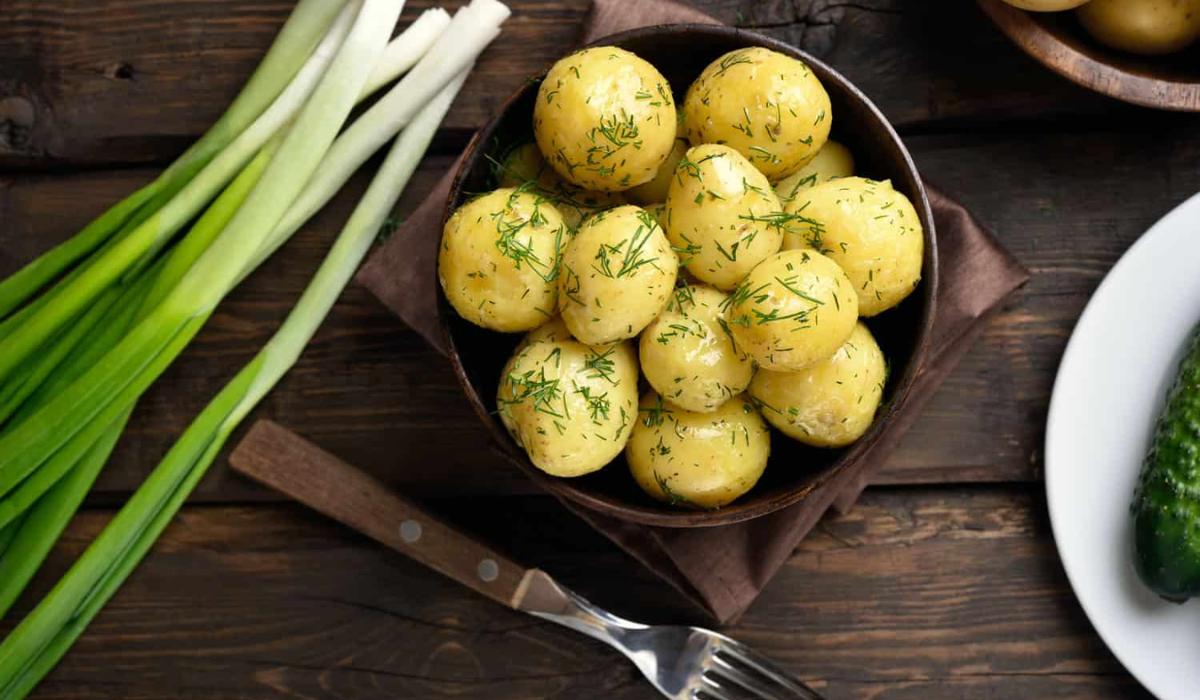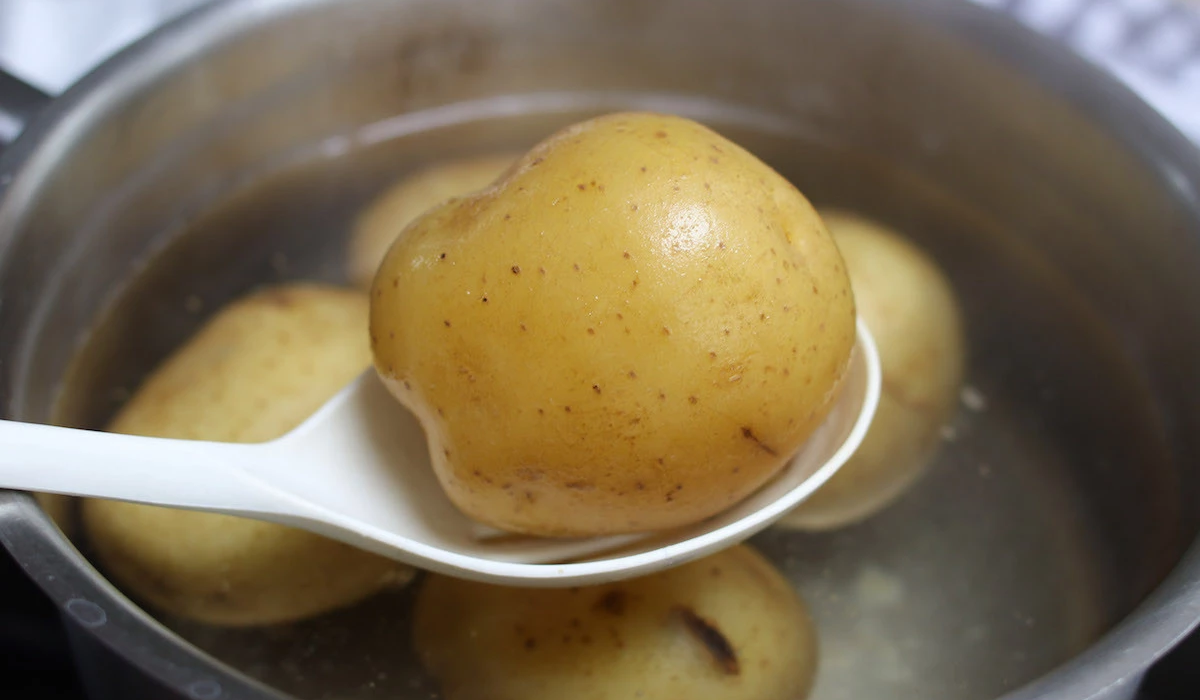Knowing how long to boil a potato is essential for preparing a delicate, flavorful dish. This article will explain how to boil potatoes properly, peel them before cooking, and par-boil them. You’ll be able to prepare potatoes at the appropriate cooking time after reading the advice in this article. We’ll thoroughly review the entire procedure with some advice on potato peeling. The sort of cooking method you select might affect the texture and flavor of potatoes. For instance, if you prefer to mash them, boil them with their skins or peel them first.
While boiling potatoes is not difficult, it is an essential cooking technique that is useful to have in your repertoire due to the numerous occasions you will use it. Because potatoes can be used in so many delectable ways, they are one of the most adaptable and popular foods. There are a few tips and tricks to ensure you’re delighted with the results no matter how you want to use your potatoes, whether you’re planning to boil potatoes for mashed potatoes or a potato salad.
Potato Nutrition Facts (Boiled)
Potato
The starchy edible tuber known as the potato is native to South America and grown worldwide. Over 1,000 kinds of tuber, domesticated for over 10,000 years, are known, albeit only a tiny portion of them are commercially grown.
Since their introduction to Europe in the 1600s, they have played a significant part in the histories and cultures of many South American nations and have been incorporated into European cuisine. Around 8,000 BCE, the wild potato was first domesticated.
Native Americans farmed many cultivars, and the tuber quickly replaced corn as a primary diet. European explorers in South America initially encountered potatoes, and the crop samples were brought back to Europe.
Given that the plants, along with eggplants and tomatoes, are members of the nightshade family, it was first challenging to introduce them to the garden. Because nightshade plants can be harmful in some parts, European farmers first had doubts about this meal. But once it was successfully grown in test areas, it was a welcome addition to the European diet.
How Long to Boil a Potato?
There are several ways to boil potatoes, with two being the most popular. Both are equally OK, so you can pick one or the other according to your preferences or the amount of time you have to boil them. In both cases, we’re going to provide you with straightforward guidance on how to boil them and how long it takes:
Method 1. Boiling Potatoes on the Stove
As there is nothing more convenient than using your stove (whatever type you have) to boil meals, this is the most popular and typical technique to cook potatoes. How to do it is as follows:
- First, you need to prepare your potatoes by washing and peeling them. You can then boil them whole or cut them into smaller pieces. This depends on your preference and the recipe you will use them with!
- Please place them in a pot full of water on the stove to boil.
- On average, potatoes will take around 10 to 15 minutes to boil. You should check them regularly by poking them with a fork. Once they feel soft, they’re ready.
- Once the potatoes are boiled, drain them and add any ingredients or seasonings according to the recipe.
- Serve and enjoy!
Method 2. Boiling Potatoes in the Microwave
If you’re in a rush or only have a short amount of time to do the task, this is a beautiful method for cooking potatoes. For other people, it’s also much simpler because the microwave is so easy to use, pleasant, and effective. How to do it is as follows:
- First, you need to prepare your potatoes by washing and peeling them. You can then boil them whole or cut them into smaller pieces. This depends on your preference and the recipe you will use them with!
- Please place them in a bowl full of water and add a teaspoon of olive oil (this will prevent them from boiling over!)
- Microwave them for 5 minutes, then check. If they’re not soft enough, microwave them for another 5 minutes and check again.
- Once they’re soft enough to be easily poked by a fork, they’re ready to be served!
Method 3. Boiling Potatoes in the Slow Cooker
While the potatoes aren’t technically boiled, this hands-off method will yield the same tender results.
- Scrub potatoes clean using a vegetable scrubber. You may also cut your potatoes into smaller pieces depending on what you’re making. Depending on personal preference, you can leave the skin on or peel it. Some argue that leaving the skin on helps them to hold their shape while boiling.
- Place your potatoes in your slow cooker. Cover with an inch of water or broth.
- Cook the potatoes on low for six to eight hours, or until fork-tender.
- Drain potatoes in a colander. To rapidly cool potatoes for recipes that call for cooled potatoes, you may submerge them in an ice bath.
Method 4. Boiling Potatoes in the Instant Pot
The Instant Pot offers a slow cooker’s hands-off cooking style with the stovetop method’s cooking time.
- Scrub potatoes clean using a vegetable scrubber. You may also cut your potatoes into smaller pieces depending on what you’re making. Depending on personal preference, you can leave the skin on or peel it. Some argue that leaving the skin on helps them to hold their shape while boiling.
- Place the trivet in the inner pot. Arrange potatoes on top. Add one cup of water or broth.
- Close the lid to the Instant Pot, cook, and switch the valve to the sealing position. Use the steam function for cooking the potatoes until tender, or 5 minutes for small potatoes and 10 minutes for larger ones.
- Allow the pressure to release naturally. Open the lid and remove the potatoes. To rapidly cool potatoes for recipes that call for cooled potatoes, you may submerge them in an ice bath.
Types of Potatoes for Boiling
While almost any potato can be boiled, you’ll find that some potatoes are best suited to certain types of recipes:
- Baking Potatoes: Starchy potatoes like Russets, Idahos, Purple potatoes, Yams, and Sweet Potatoes have a floury texture that disintegrates quickly and is suitable for mashed potatoes only.
- All-purpose Potatoes: Medium-starch potatoes like Yukon Gold and Red Gold will hold their shape and are suitable for potato salads, soups, casseroles, etc. They typically have yellow flesh.
- Waxy Potatoes: Low-starch potatoes such as Round White, Round Red (Red Bliss), and Fingerling are classic boiling potatoes that will retain their shape and are also suitable for use in potato salads, soups, casseroles, etc. They usually have white flesh.
What are the Health Benefits of Potatoes?
The Health benefits of potatoes include the following:
May Promote Weight Gain
According to a European Journal of Clinical Nutrition study, potatoes may be predominantly composed of carbs, contain protein, and have minimal fat content.
They may form an excellent diet for persons who desire to gain weight when combined with foods like cheese, butter, or cream.
Vitamin C and the B-complex may be present in the vitamin content, which may also aid in the efficient absorption of carbs.
It May be Easy to Digest
Because potatoes may be primarily composed of carbs, they are simple to digest and may help with digestion. This characteristic may make them a suitable diet for infants or people who cannot digest hard food but require energy. However, remember that consuming an excessive amount of them frequently may eventually lead to acidity.
It may be High in Fiber.
Additionally, potatoes may have a sizable amount of fiber or roughage. This could increase gastric juice secretion and stimulate peristaltic action, facilitating digestion and warding off problems like constipation.
Due to its high fiber content, the vegetable may also shield the body from dangerous illnesses like colon cancer. Additionally, fiber has been linked to removing cholesterol from the arteries and blood vessels, potentially enhancing heart health.
May Aid in Skin Care
The minerals potassium, magnesium, phosphorus, and zinc, as well as the vitamins C and B-complex, may be beneficial for the skin. In addition, the pulp made from crushed raw potatoes may be effective in the face and skin packs when combined with honey.
Even skin blemishes and patches may benefit from this. Once more, if applied externally to burns, this pulp may offer prompt comfort and speed up healing. Tough skin can be softened with mashed potatoes and water used to wash them, especially around the elbows.
May Lower Blood Pressure
Numerous conditions, such as diabetes, stress, being overweight or obese, indigestion, and poor dietary choices, can result in high blood pressure. Potatoes can be used to treat high blood pressure from a variety of factors, including stress.
Additionally, the fiber they provide may aid in decreasing cholesterol. Furthermore, because potassium acts as a vasodilator, the potassium in potatoes (46 percent of the daily need per serving) may reduce blood pressure.
Can we Consume Boiled Potato for Weight Loss?
Many people trying to lose weight frequently ponder whether potatoes are effective, and they wonder if eating boiling potatoes can help them lose weight. It all depends on how they are made and how many of them you have. The power of boiled potatoes for weight loss is fantastic. When you wish to eat this protein source high in carbohydrates, you can have it with baked, mashed, or steamed potatoes.
The popularity of the potato diet weight reduction plan is quickly rising. Continue reading to learn more about this strategy and how to consume boiling potatoes to lose weight.
- As part of this short-term diet, you must only eat potatoes for three to five days. It is meant to improve the dieter’s health while accelerating weight loss.
- Eat 1-2 kilos daily, depending on your hunger, and refrain from eating anything else during the diet. Use sea salt instead of table salt for the best results. Black tea and herbal teas are good beverages without milk or sugar.
- Consuming a lot of potatoes can help you regulate your hunger better and help you lose weight because they will keep you fuller for longer. Many people adhere to this diet. Many people who enjoy potatoes frequently inquire whether they are effective for weight loss to enjoy such diets.
Conclusion
Although boiling potatoes looks simple, there are several challenges. It’s crucial to understand that water is the enemy of potatoes. The potatoes are cooked, but if they soak for too long, they will become waterlogged. Additionally, watery potatoes will be flavorless (they will leach into the water) and be gritty, crumbly, and mushy no matter what kind of potato you are cooking.
B-complex vitamins, potassium, phosphorus, and vitamin C are among the vitamins and minerals that are naturally abundant in boiled potatoes. Due to their low calorie and fat content as well as high fiber content, they make you feel satiated. Potatoes are not naturally fattening, despite what many people think. If you season potatoes with butter or sour cream, the calories and fat they contain increase substantially. Instead, if you’re attempting to lose weight, season potatoes with herbs or low-calorie sauces.



